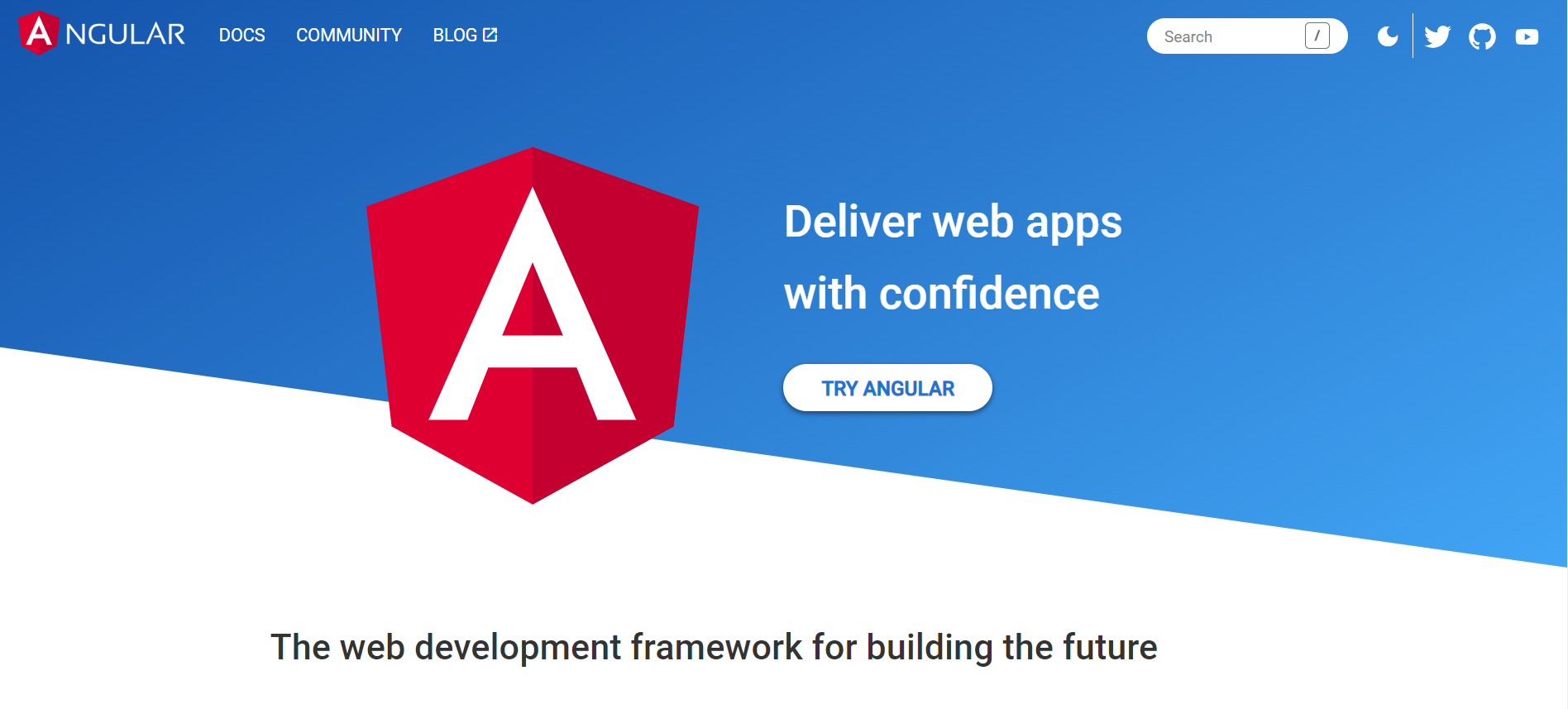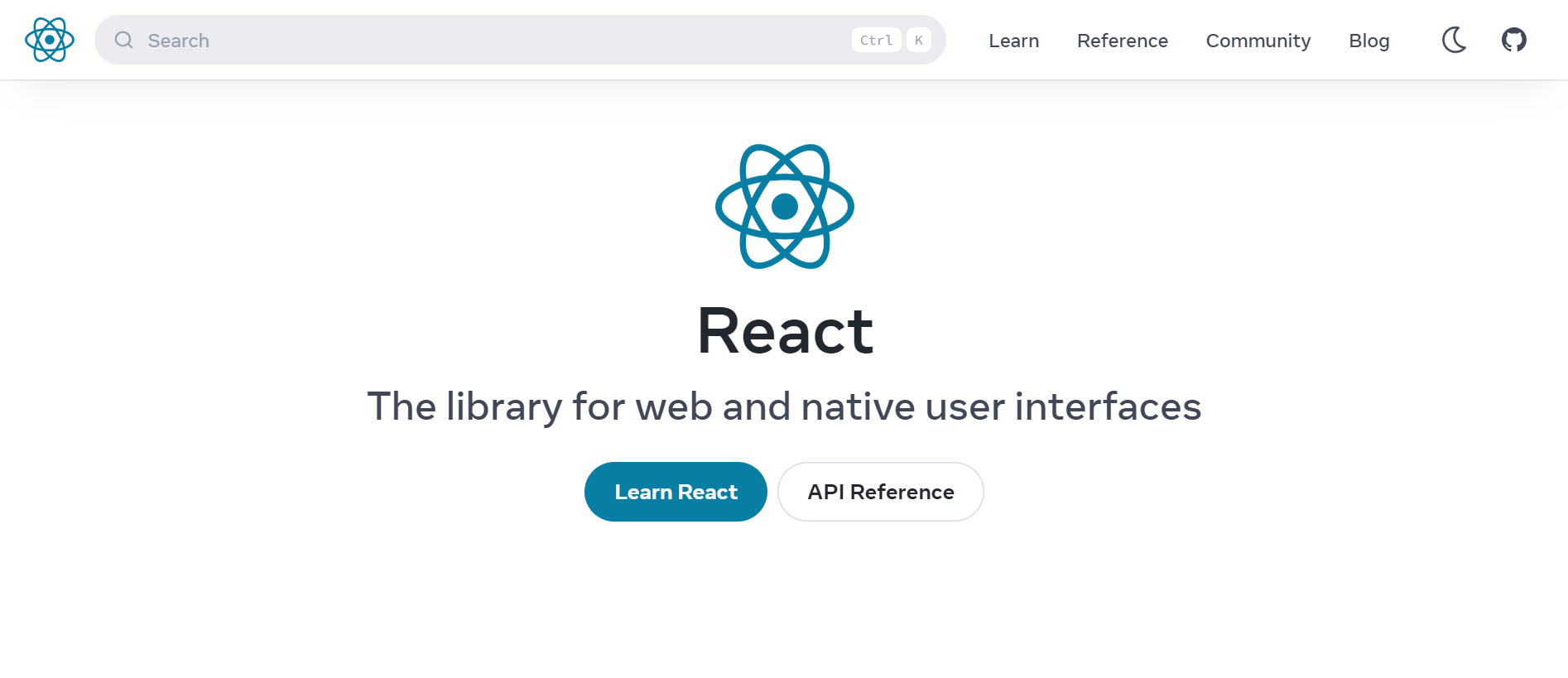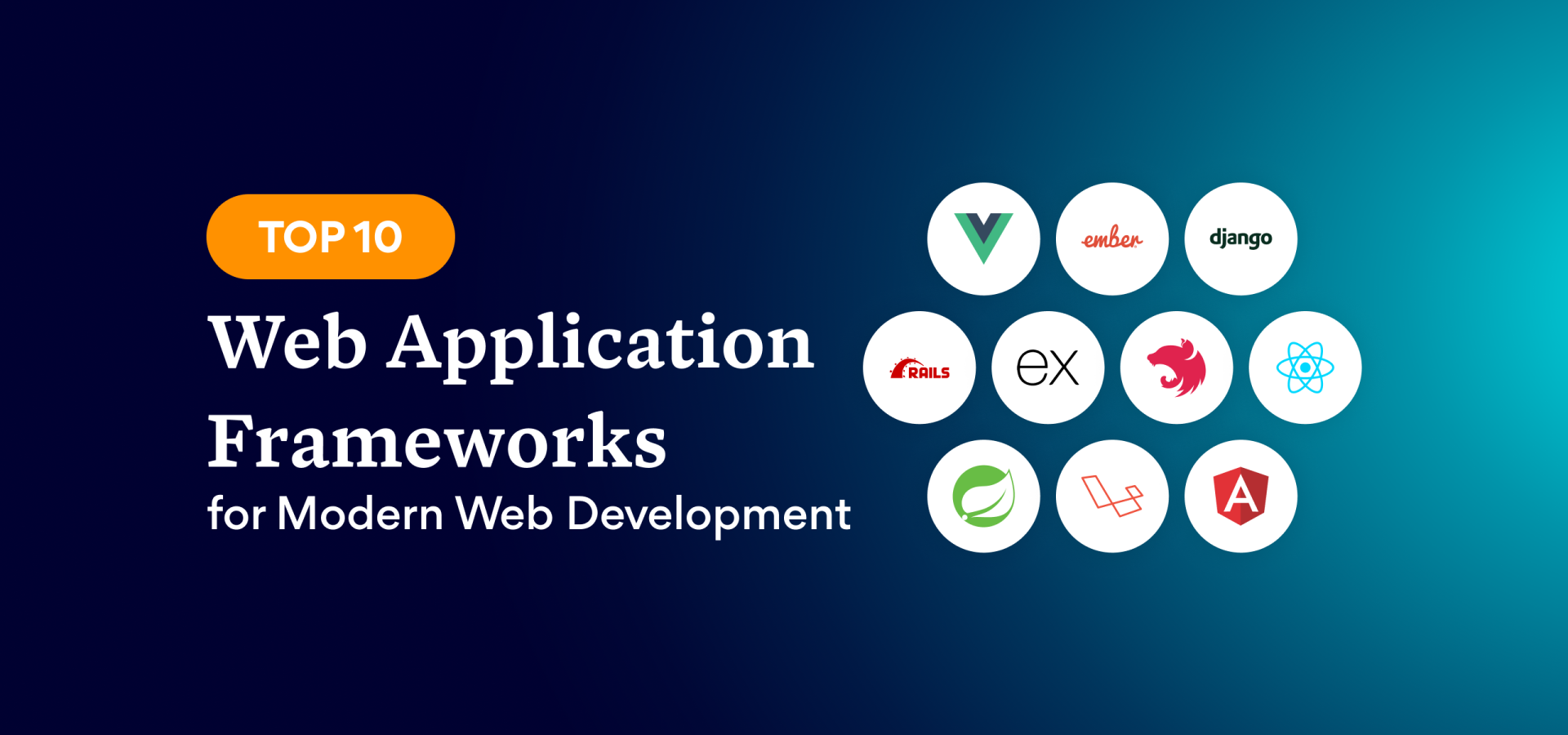Posted on
August 10, 2023
Updated on
March 26, 2024
Read time
 17 mins read
17 mins read
Web application frameworks are a lot like LEGO. They offer pre-built components, tools, technologies, and languages — the “digital building blocks” — to build web platforms.
The pre-built components and tools provided by these frameworks work as a solid foundation that helps in saving time, effort, and ensuring smoother development workflows.
As a web development company, we’ve used various web frameworks to build advanced platforms in the past decade. So we decided to curate the list of the top ten web application frameworks out in the market. The list includes both frontend frameworks and backend frameworks, each selected based on performance, scalability, ease of use, popularity, and community support. You’ll learn their features, purposes, best uses, and real-world cases. And by the end, you’ve completed reading, you’ll have a sound understanding of each framework to help you pick the right one for your project.
Sounds like a plan? Let’s dive in.
We answer all these questions and more in this blog:
Top 10 Web Application Frameworks
Angular

- Language: TypeScript (JavaScript)
- Framework Link: angular.io
- GitHub Link: github.com/angular/angular
- Release Date: September 2016
Angular is frequently the first thought in discussions about web application frameworks. It a powerful and feature-rich JavaScript web framework developed and maintained by Google. With a focus on building dynamic, single-page web applications, Angular offers an extensive set of tools and features to streamline the entire development process.
It follows a component-based architecture, allowing developers to break down complex user interfaces into smaller, reusable components, promoting code modularity and maintainability.
Built on top of TypeScript, Angular provides static typing, classes, and interfaces, enhancing code readability and facilitating early error detection. Angular’s two-way data binding simplifies data synchronization between the model and the view, reducing manual DOM manipulation.
Core features
- Component-based Architecture: Angular follows a component-based architecture, enabling developers to break down complex user interfaces into smaller, reusable components. This promotes clean code organization and makes it easier to maintain and update applications.
- TypeScript Support: Angular is built on top of TypeScript, which provides static typing, classes, and interfaces to JavaScript. TypeScript enhances code readability, provides better tooling support, and helps catch errors early in the development process.
- Two-way Data Binding: Angular offers two-way data binding, allowing automatic synchronization of data between the model and the view. This simplifies handling user input and updating the underlying data without manual DOM manipulation.
- Dependency Injection: Angular provides a robust dependency injection system that facilitates the management and injection of components, services, and other dependencies. This improves testability and modularity.
Angular’s purpose
Angular was developed to address the challenges of building complex, data-driven web applications. By providing a comprehensive set of tools and features, Angular aims to streamline the entire development process, from prototyping to production.
Popular projects made with Angular
- Gmail: Google’s email service uses Angular to deliver a seamless and interactive user experience. Angular’s capabilities in managing complex UI interactions are well-suited for Gmail’s feature-rich interface.
- Microsoft Office 365: Microsoft’s cloud-based productivity suite utilizes Angular to provide a modern and responsive user interface. Angular’s component-based architecture helps manage the complexity of the various Office 365 applications.
- Weather.com: The popular weather forecasting website employs Angular to create a smooth and interactive user experience. Angular’s data binding capabilities allow real-time updates of weather information on the site.
When to use Angular?
Angular is an excellent choice for projects that require rich and interactive user interfaces, especially for single-page applications. It is well-suited for large-scale, enterprise-level applications that demand maintainability, testability, and scalability.
React

- Language: JavaScript
- Framework Link: react.dev
- GitHub Link: github.com/facebook/react
- Release Date: March 2013
Though React is technically a library rather than a full framework, its significance in modern web development is substantial. Released by Facebook in March 2013, it is a widely used JavaScript library for building user interfaces. Its foundation lies in a component-based architecture, which breaks down user interfaces into reusable components. This approach promotes code modularity and reusability.
React excels in creating interactive and complex interfaces through a declarative syntax that describes UI appearances at any given moment. Additionally, React leverages a virtual DOM for efficient rendering, optimizing performance by minimizing unnecessary updates to the actual DOM. The performance, scalability, and large community support that React provides has made it a top web development technology.
Core features
- Component-based Architecture: React follows a component-based architecture, allowing developers to build modular and reusable UI components.
- Virtual DOM: React uses a virtual DOM to efficiently update the actual DOM, reducing performance bottlenecks and improving UI rendering.
- Declarative Syntax: React’s declarative syntax allows developers to describe the UI at any point in time, making it easy to build dynamic and interactive interfaces.
React’s Purpose
React was developed to provide a high-performance and scalable library for building user interfaces and single-page applications.
Popular projects made with React
- Facebook: Facebook itself uses React extensively for various frontend features, leveraging React’s component-based architecture and performance.
- Instagram: The popular social media platform, Instagram, utilizes React to deliver a seamless and interactive user experience.
- Airbnb: Airbnb’s frontend user interface is built using React, showcasing React’s capabilities for large-scale and high-traffic applications.
When to use React?
React is an excellent choice for projects where performance, scalability, and maintainability are critical, especially for applications with complex and interactive user interfaces.
Vue.js

- Language: JavaScript
- Framework Link: vuejs.org
- GitHub Link: github.com/vuejs/vue
- Release Date: February 2014
Vue.js is a progressive JavaScript framework for building user interfaces. Released in February 2014, Vue.js is designed to be approachable and flexible, making it easy to integrate into existing projects. Vue.js follows a reactive data binding model and offers a virtual DOM for efficient rendering.
It is often compared to other JavaScript frameworks like React and Angular, and it has gained popularity due to its simplicity and small size. This web framework is widely used for creating interactive user interfaces, single-page applications, and complex web applications.
Core Features
- Reactive Data Binding: Vue.js uses a reactive data binding model, automatically updating the DOM when data changes, simplifying UI updates.
- Components: Vue.js allows developers to create reusable components, enabling a structured and modular approach to building web applications.
- Virtual DOM: Vue.js uses a virtual DOM to efficiently update the actual DOM, improving performance and reducing unnecessary reflows.
Vue.js’ purpose
Vue.js was created to offer a progressive and approachable framework for building user interfaces and single-page applications.
Popular projects made with Vue.js
- Alibaba: Alibaba’s e-commerce platform, Taobao, uses Vue.js for its frontend user interface, taking advantage of Vue.js’ ease of integration and fast rendering capabilities.
- Xiaomi: Xiaomi, the Chinese electronics company, employs Vue.js for its website and online shopping platform, showcasing Vue.js’ capabilities for building responsive and interactive user interfaces.
- Grammarly: Grammarly, the popular writing assistant tool, utilizes Vue.js for its frontend interface, making it user-friendly and interactive.
When to use Vue?
Vue.js is an ideal web application framework for projects where simplicity, ease of integration, and incremental adoption are essential.
Ember.js

- Language: JavaScript
- Framework Link: emberjs.com
- GitHub Link: github.com/emberjs/ember.js
- Release Date: December 2011
Ember.js is a JavaScript frontend framework that follows the “convention over configuration” approach, providing developers with everything they need to build ambitious web applications.
Released in December 2011, Ember.js focuses on reducing boilerplate code and promoting best practices, allowing teams to create scalable and maintainable applications. Ember.js provides a set of tools, including an expressive templating engine, a router for managing application states, and an integrated development environment (Ember CLI) for efficient project management.
Core Features
- Convention over Configuration: Ember.js follows the “convention over configuration” principle, making it easy to get started with pre-configured defaults and minimal setup.
- Templating Engine: Ember.js provides an expressive templating engine, enabling developers to create dynamic and reusable templates with ease.
- Routing: Ember.js has a built-in router to manage application states and transitions, providing a seamless user experience.’
Ember.JS’ purpose
Ember.js was developed to provide a robust and opinionated framework for building scalable and ambitious web applications.
Popular projects made with Ember.js
LinkedIn: LinkedIn uses Ember.js for its frontend to deliver a smooth and engaging user experience.
Apple Music: Apple Music, the popular music streaming service, employs Ember.js for its frontend to provide users with a seamless music discovery experience.
Square: Square, the financial services company, utilizes Ember.js to build intuitive and scalable web applications for its merchant solutions.
When to use Ember.js?
Ember.js is an excellent choice for projects that value conventions, best practices, and the ability to scale as the application grows.
Django

- Language: Python
- Framework Link: djangoproject.com
- GitHub Link: github.com/django/django
- Release Date: July 2005
Django is a high-level Python web framework known for its simplicity, productivity, and scalability. Released in July 2005, Django follows the “don’t repeat yourself” (DRY) principle, promoting code reuse and a clean, pragmatic design. It includes an object-relational mapper (ORM) for database interactions, a powerful admin interface for content management, and robust security features.
Django’s built-in authentication system and support for middleware make it a secure choice for web development. It is widely used for building web applications, content management systems (CMS), and APIs.
Core features
- Object-Relational Mapper (ORM): Django provides a powerful and intuitive ORM, allowing developers to interact with the database using Python objects.
- Admin Interface: Django includes a fully-featured admin interface for content management, making it easy to manage website content without additional development.
- Security: Django comes with built-in security features, such as authentication and protection against common web vulnerabilities.
Django’s purpose
Django was developed to simplify and speed up web development, allowing developers to build robust and scalable applications quickly.
Popular projects made with Django
- Instagram: Instagram, the popular social media platform, was originally built with Django, showcasing Django’s capabilities for large-scale applications.
- Spotify: Spotify, the music streaming service, uses Django to manage its content and deliver a seamless user experience.
- Disqus: Disqus, the popular commenting platform, is built with Django, highlighting Django’s flexibility for integrating with various websites.
When to use Django?
Django is an excellent choice for projects that prioritize rapid development, security, and scalability, especially for content-heavy applications and APIs.
Ruby on Rails (Rails)

- Language: Ruby
- Framework Link: rubyonrails.org/
- GitHub Link: github.com/rails/rails
- Release Date: December 2005
Ruby on Rails, often referred to as Rails, is a full-stack web application framework written in Ruby. Released in December 2005, Rails embraces the “convention over configuration” philosophy, allowing developers to focus on application logic instead of boilerplate code.
Rails follows the Model-View-Controller (MVC) architectural pattern, simplifying the development process and promoting code organization. It includes an intuitive object-relational mapping (ORM) system, a powerful set of generators (Rails CLI) for code scaffolding, and built-in support for RESTful APIs. Rails has gained popularity for its developer-friendly nature and rapid development capabilities.
Core features
- Convention over Configuration: Rails follows the “convention over configuration” principle, reducing the need for manual configuration and minimizing repetitive tasks.
- Model-View-Controller (MVC): Rails follows the MVC pattern, separating the application into distinct components, simplifying code organization.
- Generators: Rails provides a set of generators, enabling developers to create common components, such as models, controllers, and views, quickly.
Rail’s purpose
Rails was developed to provide a developer-friendly framework that emphasizes productivity and rapid development.
Popular projects made using Rails
- GitHub: GitHub itself is built on Rails, showcasing Rails’ capabilities for hosting and managing large-scale code repositories.
- Basecamp: Basecamp, the project management and collaboration tool, was built with Rails, highlighting Rails’ ability to deliver a feature-rich web application.
- Airbnb: Airbnb initially used Rails to build its platform, taking advantage of Rails’ rapid development features for early iterations of the website.
When to use Rails?
Rails is an excellent choice for projects that prioritize speed of development, code simplicity, and convention-driven architecture.
Express.js

- Language: JavaScript (Node.js)
- Framework Link: expressjs.com
- GitHub Link: github.com/expressjs/express
- Release Date: May 2010
Express.js is a minimalist and flexible web framework for Node.js, written in JavaScript. Known for its unopinionated nature, Express allows developers to choose the libraries and tools they prefer. Released in May 2010, Express was created to provide a simple and unobtrusive way to build web applications using Node.js. It serves as the foundation for many Node.js web frameworks and is widely used for creating web servers, handling routes, and building RESTful APIs. Its lightweight and fast nature make it an excellent choice for developing single-page applications (SPAs) and real-time web applications.
Core features
Minimalist: Express.js is minimalist, providing just enough features to build web applications without imposing unnecessary decisions.
Middleware Support: Express.js offers a robust middleware ecosystem, allowing developers to extend and customize the application’s functionality.
Routing: Express.js provides a simple and flexible routing system for handling HTTP requests.
Express.js’ purpose
Express.js was developed to offer a lightweight and unopinionated framework for building web applications with Node.js.
Popular projects made Express.js
- Trello: Trello, the project management tool, uses Express.js for its backend to handle real-time updates and user interactions.
- Uber: Uber, the ride-sharing platform, leverages Express.js for handling API requests and managing real-time data.
- MyFitnessPal: MyFitnessPal, the fitness tracking application, utilizes Express.js to provide a seamless user experience for managing personal fitness data.
When to use Express.js?
Express.js is an excellent choice for projects where flexibility, performance, and the ability to work with other Node.js libraries are crucial.
NestJS

- Language: Typescript
- Framework Link: nestjs.com
- GitHub Link: github.com/nestjs/nest
- Release Date: December 2017
NestJS, a scalable Node.js framework, draws inspiration from Angular’s architectural principles to deliver efficient server-side application development. Its modular architecture fosters code organization and reusability, while TypeScript ensures clarity and early error detection. Built-in dependency injection simplifies component management.
NestJS supports technologies like WebSockets, GraphQL, and microservices, catering to diverse application needs. While not a traditional framework, its blend of architectural principles, modularity, and TypeScript empowers developers to create scalable, maintainable, and high-performance server-side applications. Whether building enterprise systems or adopting microservices, NestJS enhances modern backend development.
Core Features
- Modular Architecture: NestJS follows a modular architecture, allowing developers to break down applications into smaller, reusable modules, promoting clean code organization and scalability.
- TypeScript Support: NestJS leverages TypeScript, providing static typing, classes, and interfaces, leading to better tooling support and improved code integrity.
- Dependency Injection: NestJS provides a built-in dependency injection system, making it easy to manage and inject dependencies across the application.
- Built-in Support: NestJS includes support for WebSockets, GraphQL, and microservices, enhancing its capabilities for various application needs.
NestJS’ purpose
NestJS was created to address the demands of building robust and scalable server-side applications. By leveraging the benefits of TypeScript and its modular architecture, NestJS streamlines the development process and promotes maintainable, enterprise-grade applications.
Popular projects made with NestJS
- Serenity: A web-based application for managing and organizing internal events, built using NestJS for its performance and scalability.
- Doodle: A collaborative scheduling web application that utilizes NestJS for its real-time capabilities and robustness.
- Scrumlr: An online retrospective tool that leverages NestJS for its efficiency in handling real-time data and user interactions.
When to use NestJS?
NestJS is best suited for building scalable, enterprise-level applications, microservices architectures, real-time applications, and APIs, especially when leveraging TypeScript proficiency.
Spring Boot

- Language: Java
- Framework Link: spring.io/projects/spring-boot
- GitHub Link: github.com/spring-projects/spring-boot
- Release Date: April 2014
Spring Boot is a powerful and popular backend framework for Java-based applications. Released in April 2014, Spring Boot is part of the Spring Framework ecosystem and focuses on making it easy to create stand-alone, production-grade applications with minimal configuration.
It embraces the “convention over configuration” philosophy, reducing the need for boilerplate code. Spring Boot provides a range of features, such as auto-configuration, embedded servers, and support for various data sources. It is widely used for building RESTful APIs, microservices, and enterprise-grade applications.
Core features
- Auto-configuration: Spring Boot automatically configures the application based on the classpath, reducing the need for manual configuration.
- Embedded servers: Spring Boot includes support for embedded servers like Tomcat, Jetty, and Undertow, making it easy to run applications without external containers.
- Spring ecosystem: Spring Boot integrates seamlessly with other Spring projects, providing a robust ecosystem for building Java-based applications.
Purpose
Spring Boot was developed to simplify and accelerate the process of building Java applications, promoting best practices and maintainability.
Popular projects made with Spring Boot
- Netflix: Netflix, the popular streaming service, uses Spring Boot extensively for building microservices that power its backend infrastructure.
- Trello: Trello utilizes Spring Boot to build and maintain its backend API for managing user boards and cards.
- PayPal: PayPal, the online payment platform, leverages Spring Boot for developing secure and reliable APIs for its payment services.
When to use Spring Boot?
Spring Boot is an excellent choice for projects that require rapid development, ease of deployment, and strong integration with other Spring projects.
Laravel

- Language: PHP
- Framework Link: laravel.com
- GitHub Link: github.com/laravel/laravel
- Release Date: June 2011
Laravel is a PHP web framework known for its elegant syntax, developer-friendly nature, and expressive features. Released in June 2011, Laravel follows the “convention over configuration” principle, reducing repetitive tasks and making development enjoyable. Laravel includes a robust ORM, a powerful templating engine (Blade), and features like authentication, routing, and caching out of the box. It is widely used for developing web applications, APIs, and content management systems.
Core Features
- Eloquent ORM: Laravel provides the Eloquent ORM, allowing developers to interact with the database using expressive, object-oriented syntax.
- Blade Templating Engine: Laravel includes the Blade templating engine, making it easy to create dynamic and reusable templates.
- Artisan CLI: Laravel comes with a powerful command-line tool, Artisan, which simplifies common development tasks.
Laravel’s purpose
Laravel was developed to provide an expressive and elegant framework for building PHP web applications with a focus on developer productivity.
Popular projects made with Laravel
- Laravel Forge: Laravel Forge is a server management tool built with Laravel, showcasing Laravel’s capabilities for backend application development.
- Laravel Nova: Laravel Nova, the administration dashboard for Laravel applications, utilizes Laravel’s features to provide a seamless user experience for managing application data.
- Flare: Flare, an error tracking service, is built with Laravel, highlighting Laravel’s robust features for managing application errors and exceptions.
When to use Laravel?
Laravel is an excellent choice for projects that require rapid development, expressive syntax, and a vibrant community.
Selecting the ideal framework for your project
In conclusion, we’ve delved into the top 10 web application frameworks, providing you with a comprehensive understanding of each one’s strengths and capabilities. As you move forward with your project, we want to ensure a smooth decision-making process when selecting the ideal framework for your needs.
To streamline your selection, consider the following factors:
- Type of application: Identify the specific nature of your project. Certain frameworks excel at building complex web applications, while others are better suited for crafting RESTful APIs or simple websites. Choosing the right fit will ensure optimal performance and functionality.
- Programming language: Take into account your familiarity with programming languages. Frameworks written in languages you are proficient in will empower you to work more efficiently and with greater confidence.
- Size and complexity: Evaluate the scope and intricacy of your application. Opt for a framework that aligns with your project’s size to avoid unnecessary complexities in development.
- Community support: Consider the level of community engagement and support surrounding each framework. Active communities and extensive documentation can be invaluable resources when seeking assistance or troubleshooting.
Considering these factors, you should be able to select the ideal web framework that perfectly fits your project’s unique needs. Use these “digital building blocks” for the success of your web application development. And if you need any assistance in leveraging these frameworks to create efficient, scalable, and innovative web solutions, don’t hesitate to reach out to us.








